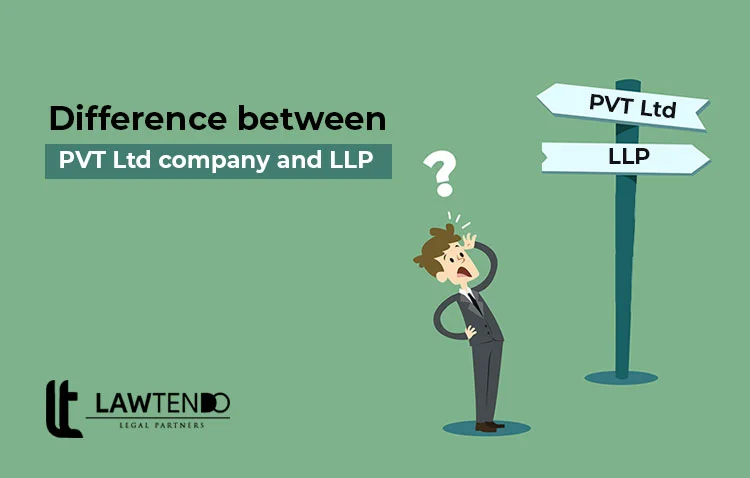Difference between Private limited Company and LLP

Date : 02 Jul, 2020
Post By Jonica E
PRIVATE COMPANY (Pvt Company) Section 2(68) of Companies Act, 2013 characterizes private companies. As indicated by that, Private limited company are those companies whose articles of association confine the transferability of shares and keep general society everywhere from buying into them. The Section further says Pvt Company can have a limit of 200 individuals (aside from One Person Companies). This number does exclude present and previous representatives who are additionally individuals. In addition, multiple people who own shares mutually are treated as a solitary part. LIMITED LIABILITY PARTNERSHIP (LLP Company) The Limited Liability Partnership (LLP) is seen as an option corporate business vehicle that gives the advantages of limited liability however permits its individuals the adaptability of sorting out their interior structure as a partnership dependent on a commonly shown up understanding. The LLP Company would empower business visionaries, professionals and ventures offering types of the assistance of any sort or occupied with logical and specialized controls, to frame financially productive vehicles fit their necessities. Inferable from adaptability in its structure and activity, the LLP would likewise be an appropriate vehicle for little endeavours and for speculation by funding. Section 2(7), r.w. section 226 of The Companies Act, 1956 – Body Corporate or Corporation– Definition of – Limited Liability Partnership specified as a body corporate for the purpose of section 226(3)(A). UNDERSTANDING THE DIFFERENCES A. LIMITED LIABILITY PARTNERSHIP (LLP Company) 1. An LLP is a cross-type of the association having highlights of a partnership firm under the Partnership Act, 1932 and an organization under the Companies Act, 1956/2013. 2. The LLP's are regulated by the Registrar of Companies. 3. Liability of partners is limited aside from where an Act is completed by the LLP with a plan to dupe leasers or some other individual or for any fake reason. 4. LLP is a body corporate and a legitimate substance separate from its partners. It has an unending progression. In this way, an LLP is proficient, in its own name, of procuring, possessing, holding, discarding property, regardless of whether portable, ardent, substantial or elusive. It can sue and can be sued, and can do and enduring different acts as a body corporate may do or endure. 5. There is no restriction on a number of partners. 6. Rights and obligations of partners of an LLP and shared rights and obligations between an LLP and its partners are administered by the LLP Agreement between the partners or between the LLP and its partners. 7. Partners are specialists of LLP yet not the operators of different partners. 8. An individual or body corporate may turn into a partner in LLP. 9. LLP must-have in any event two people as Designated Partners. In any event, one of the Designated Partners must be an occupant in India. A body corporate partner of the LLP may choose a person as a Designated Partner. 10. LLP must keep up legitimate books of record. The records might be on money premise or collection premise. 11. Records of LLP are required to be examined. Be that as it may, an LLP whose turnover in any monetary year doesn't surpass ₹40 lakhs or the commitment (capital) doesn't surpass ₹25 lakhs is excluded from the arrangements of review. 12. LLP is required to record Statement of Account and Solvency and Annual Return in the recommended structure each year. 13. LLP is required to record data about the LLP Agreement, changes in the LLP Agreement and changes in points of interest of assigned partners and partners. 14. Right of a partner to share profits and misfortunes is transferable. 15. An individual speaking to himself to be a partner or allowing himself to be spoken to as a partner of an LLP is at risk to individual giving credit the LLP depending on such portrayal. 16. The idea of 'Whistle-Blower' is joined in the LLP Act. 17. A partnership under the Partnership Act, 1932 might be changed over into an LLP. A private organization or an unlisted open organization may likewise be changed over into an LLP gave there is no 'security interest' remaining alive on the date of utilization for transformation. 18. Arrangements made in the LLP Act for examination concerning the undertakings of an LLP by the overseer to be named by the Central Government. 19. Arrangements made in the LLP Act for Compromise, Arrangement or Reconstruction of an LLP and amalgamation of LLPs. For this reason, application to be made to National Company Law Tribunal to be comprised under section 10FB of the Companies Act, 1956/408 of the Companies Act, 2013. Pending the constitution of such Tribunal under the two Acts, application to be made to the High Court. 20. All filings under the LLP Act to be done electronically. So also, the Registrar may outfit data or give duplicates and extracts confirming the equivalent by joining advanced mark. 21. Substantial punishments have been given if there should arise an occurrence of the rebelliousness of arrangements of the LLP Act. 22. For the reasons for tax collection, and Indian LLP is treated compared to a partnership firm under the Partnership Act, 1932. B. PRIVATE LIMITED COMPANY (Pvt Company) 1) Members: To shape a private limited organization least of 2 individuals and a limit of 200 individuals according to the arrangements of Companies Act, 2013. 2) Limited Liability: The liability of the individuals in Private limited is limited to the number of shares held by them. For instance, if the organization faces any misfortunes under any conditions the shareholders are obligated uniquely to the shares held by them. The individual resources possessed by the shareholders are not in danger. 3) Perpetual Succession: The Pvt Ltd company exists according to the law even if there should be an occurrence of death, indebtedness or liquidation of any of its individuals. This implies the life of the organization continues existing until the end of time. 4) Register of Members: There is no impulse for the Pvt Company to keep up the register of individuals as required by an open limited organization. 5) Directors Requirement: Required of Directors on account of a Private Limited organization is just 2. With at least 2 executives, an organization can carry on its activities. 6) Paid-up Capital: A Private Limited Company must have a base capital of rupees one lakh or such higher sum endorsed as a chance to time. Notwithstanding, according to the ongoing amendment, there is no such least capital necessity. 7) Prospectus: Prospectus is the itemized articulation of the issues of the organization which is given for people in general. Be that as it may, on account of a private limited organization, there is no such need to give plan. 8) Minimum Subscription: It is the sum gotten by the Pvt Ltd company which is 90% of the shares given inside a specific timeframe. In the event that the organization can't get 90% of the sum, it will have the option to initiate its business. In any case, there is no such limitation on account of a private limited organization, they can begin the business when the organization is shaped. 9) Name: The private limited organization must utilize "private limited company" or Pvt Ltd company toward the end. 2. REGISTRATION A. LIMITED LIABILITY PARTNERSHIP (LLP Company) To enroll an Indian LLP, you have to initially apply for a Designated Partner Identification Number (DPIN), which should be possible by documenting eForm for procuring the DIN or DPIN. You would then need to obtain your Digital Signature Certificate and register the equivalent on the entrance. From that point, you have to get the LLP name affirmed by the Ministry. When the LLP name is endorsed, you can enlist the LLP by recording the fused form. Step 1: Application for DIN or DPIN Step 2: Acquire/Register DSC (Digital mark authentications) Step 3: New User Registration Step 4: Incorporate an LLP Step 5: File LLP Agreement On completion of the above steps, the LLP registration will be successful and the activities and obligations can be carried on. B. PRIVATE LIMITED COMPANY (Pvt Company) Following are the steps for Pvt Ltd Company registration. Stage 1: Obtain a Digital Signature Certificate (DSC) Stage 2: Obtain DIN Stage 3: Check for name availability Stage 4: Fill Form SPICE INC-32 Stage 5: Submit MOA and AOA Stage 6: Fill PAN and TAN Application On completion of the above steps, the Pvt Ltd Company registration will be successful and the activities and obligations can be carried on. TAX LIABILITY A. LIMITED LIABILITY PARTNERSHIP (LLP Company) Income-tax: LLP is subject to pay tax at the level pace of 30% on its complete income. Surcharge: The measure of income-tax (as figured above) will be additionally expanded by an extra charge at the pace of 10% of such tax, where complete income surpasses one crore rupees. In any case, the extra charge will be dependent upon negligible alleviation (the aggregate sum payable as income-tax and overcharge will not surpass aggregate sum payable as income-tax on the all-out income of one crore rupees by more than the measure of income that surpasses one crore rupees). Cess for education and health: The measure of income-tax and the appropriate extra charge, will be additionally expanded by instruction cess and auxiliary and advanced education cess determined at the pace of four per cent of such income-tax and overcharge. b) Alternative Minimum Tax: Tax payable by LLP can't be under 18.5 per cent (expanded by Surcharge and HEC) of "adjusted total income" according to section 115JC. B. PRIVATE LIMITED COMPANY (Pvt Company) Indian Private Limited Company is viewed as an assessment inhabitant; it is along these lines qualified for a charge under Income Tax Act, 1961. Assessment pace of 30% on the complete salary and surcharge of 5% if the pay surpasses 10 Million or more 3% Education cess and Secondary and Higher Education cess on the aggregate of annual expense and surcharge. How can Lawtendo help? LawTendo has around 15000+ lawyers across India in our platform. LawTendo strives to facilitate cost-efficient and quality legal service to our clients. You can contact us at +91-9671633666 or info@lawtendo.com.





